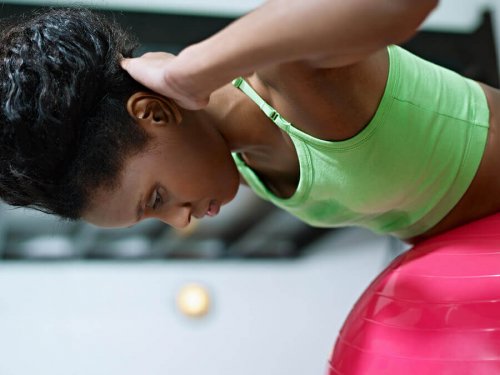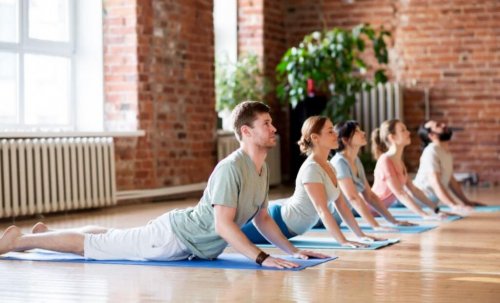Kyphosis Exercises That Help Correct Your Posture

The curvature of the spine is complex and depends on different structures to keep it in place. If you notice that your neck is hurting a lot, or you’re starting to get a hunchback, you should do kyphosis exercises to help keep your spine in a healthy position.
Kyphosis and lordosis
The first thing you need to understand is the meaning of these two words. Kyphosis actually refers to the normal curvature of the thoracic spine. The medical term for a thoracic spine that’s more curved than normal is actually hyperkyphosis, but most people use the word kyphosis to refer to the abnormal condition.
Lordosis, on the other hand, refers to the normal curvature of the cervical spine and the lumbar spine. These two types of curves are what give the spine it’s natural, anatomical form.
As we briefly mentioned before, when the curves are outside the range that’s considered normal, the following issues can arise:
- Hyperkyphosis and hyperlordosis: this is when the spine is overly curved.
- A flat back or curvature alteration: this is when the angle of the curves is reduced.
- Scoliosis: a sideways curvature of the spine.
Each of these three pathologies comes with a variety of symptoms, including muscle pain, wear and tear on the vertebrae, and herniated discs, among others. One of the main causes of these problems is a muscular imbalance, usually caused by poor posture.
Having poor posture as you go throughout your day means that your muscles have to work in an unnatural way. Consequently, they push and stretch the vertebrae, which can change the curvature of the spine.

Exercises for kyphosis
Of all the conditions listed above, kyphosis is the most common, so it’s the one we’ll focus on today. A big reason for the increase in kyphosis is our increased reliance on computers and technology. We spend much more time sitting than we ever have before, and we often sit incorrectly.
Sitting in front of the computer, lounging in front of the TV, or bending over to look at our phones can all have a negative impact on the health of your spine.
The good news is that you can correct kyphosis. If you start to have pain and discomfort, or your friends point out that your head is really far forward, studies have shown that exercises that work your paravertebral muscles can improve hyperkyphosis. Let’s look at some exercises that help with posture.
Exercises for your spine
Walking is the easiest and most effective way to maintain good paravertebral muscle tone. These are the muscles that support your spine, so anytime you’re standing, you’re automatically working those muscles.
Another easy exercise you can do is the deadlift. With your feet at shoulder-width and your knees slightly bent, lean your torso forward. Don’t let your knees pass your toes.

Keep your back straight the whole time. To modify the difficulty, change the speed of the movement.
Another exercise you can try is the following: lying facedown on the floor, lift your head and torso a few centimeters off the floor, and then lower again. Your feet and legs should remain on the floor the whole time. For an extra challenge, you can also do these on an exercise ball, as shown in the photo below.

You can also modify the difficulty by changing the position of your arms. If you keep them next to your body, that’s the easiest version. Stretching them out horizontally is harder. If you do the exercise with your arms straight over your head, that’s the most difficult.
Exercises that specifically target the back are very important, but it’s also important to work the core.
Exercises for kyphosis: stretching
In addition to strengthening your back body, stretching your front body can also help with kyphosis. Stretches that target the pectoral and abdominal muscles will help keep these muscles from pulling your spine forward.

Stretching your hamstrings is also important. If these muscles are in a shortened position, it’ll pull your pelvis backward, which changes the curvature of your lumbar spine and forces you to compensate by increasing the curvature of your thoracic spine.
Posture
This is the most critical point, though it’s not exactly an exercise. You have to learn how to sit, lay down, and move correctly. If you don’t, you’ll lose any benefits you might have gained from doing these exercises for kyphosis regularly.
In conclusion, pay attention to your posture, walk a lot, and stretch the front of your body. If you do these things consistently, your spine will thank you!
The curvature of the spine is complex and depends on different structures to keep it in place. If you notice that your neck is hurting a lot, or you’re starting to get a hunchback, you should do kyphosis exercises to help keep your spine in a healthy position.
Kyphosis and lordosis
The first thing you need to understand is the meaning of these two words. Kyphosis actually refers to the normal curvature of the thoracic spine. The medical term for a thoracic spine that’s more curved than normal is actually hyperkyphosis, but most people use the word kyphosis to refer to the abnormal condition.
Lordosis, on the other hand, refers to the normal curvature of the cervical spine and the lumbar spine. These two types of curves are what give the spine it’s natural, anatomical form.
As we briefly mentioned before, when the curves are outside the range that’s considered normal, the following issues can arise:
- Hyperkyphosis and hyperlordosis: this is when the spine is overly curved.
- A flat back or curvature alteration: this is when the angle of the curves is reduced.
- Scoliosis: a sideways curvature of the spine.
Each of these three pathologies comes with a variety of symptoms, including muscle pain, wear and tear on the vertebrae, and herniated discs, among others. One of the main causes of these problems is a muscular imbalance, usually caused by poor posture.
Having poor posture as you go throughout your day means that your muscles have to work in an unnatural way. Consequently, they push and stretch the vertebrae, which can change the curvature of the spine.

Exercises for kyphosis
Of all the conditions listed above, kyphosis is the most common, so it’s the one we’ll focus on today. A big reason for the increase in kyphosis is our increased reliance on computers and technology. We spend much more time sitting than we ever have before, and we often sit incorrectly.
Sitting in front of the computer, lounging in front of the TV, or bending over to look at our phones can all have a negative impact on the health of your spine.
The good news is that you can correct kyphosis. If you start to have pain and discomfort, or your friends point out that your head is really far forward, studies have shown that exercises that work your paravertebral muscles can improve hyperkyphosis. Let’s look at some exercises that help with posture.
Exercises for your spine
Walking is the easiest and most effective way to maintain good paravertebral muscle tone. These are the muscles that support your spine, so anytime you’re standing, you’re automatically working those muscles.
Another easy exercise you can do is the deadlift. With your feet at shoulder-width and your knees slightly bent, lean your torso forward. Don’t let your knees pass your toes.

Keep your back straight the whole time. To modify the difficulty, change the speed of the movement.
Another exercise you can try is the following: lying facedown on the floor, lift your head and torso a few centimeters off the floor, and then lower again. Your feet and legs should remain on the floor the whole time. For an extra challenge, you can also do these on an exercise ball, as shown in the photo below.

You can also modify the difficulty by changing the position of your arms. If you keep them next to your body, that’s the easiest version. Stretching them out horizontally is harder. If you do the exercise with your arms straight over your head, that’s the most difficult.
Exercises that specifically target the back are very important, but it’s also important to work the core.
Exercises for kyphosis: stretching
In addition to strengthening your back body, stretching your front body can also help with kyphosis. Stretches that target the pectoral and abdominal muscles will help keep these muscles from pulling your spine forward.

Stretching your hamstrings is also important. If these muscles are in a shortened position, it’ll pull your pelvis backward, which changes the curvature of your lumbar spine and forces you to compensate by increasing the curvature of your thoracic spine.
Posture
This is the most critical point, though it’s not exactly an exercise. You have to learn how to sit, lay down, and move correctly. If you don’t, you’ll lose any benefits you might have gained from doing these exercises for kyphosis regularly.
In conclusion, pay attention to your posture, walk a lot, and stretch the front of your body. If you do these things consistently, your spine will thank you!
All cited sources were thoroughly reviewed by our team to ensure their quality, reliability, currency, and validity. The bibliography of this article was considered reliable and of academic or scientific accuracy.
- Nonsurgical treatment of kyphosis. Pizzutillo P.D. Instructional Course Lectures [01 Jan 2004, 53:485-491]
- Spinal extension exercises prevent natural progression of kyphosis. Ball, J.M., Cagle, P., Johnson, B.E. et al. Osteoporos Int (2009) 20: 481. https://doi.org/10.1007/s00198-008-0690-3
- Age-Related Hyperkyphosis: Its Causes, Consequences, and Management. Katzman W.B., Wanek L., Shepherd J.A., and Sellmeyer D.E.. Journal of Orthopaedic & Sports Physical Therapy 2010 40:6, 352-360
This text is provided for informational purposes only and does not replace consultation with a professional. If in doubt, consult your specialist.








